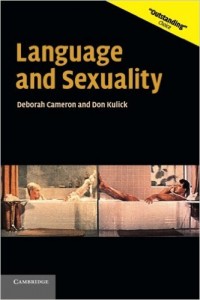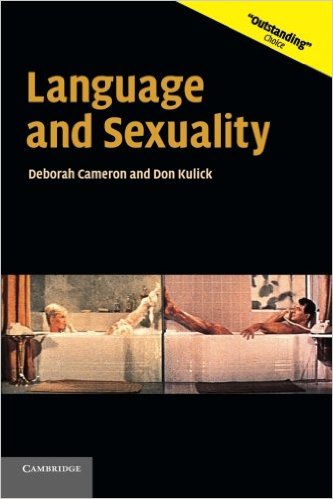 Language and Sexuality
Language and Sexuality
by Deborah Cameron and Don Kulick
Cambridge University Press
176 pages, $21. (paper)
“WHAT IS SEX?” Language and Sexuality opens with a question that was prompted by President Clinton’s denial that he had “had sex” with Monica Lewinsky. Authors Deborah Cameron and Don Kulick, a lesbian and a gay man, attempt to answer this question by navigating a maze of 1960’s and 70’s lesbian feminist and gay liberation writings, and through the subsequent literature of queer theory, making excursions into the language of S/M practitioners, campus policies to prevent sexual assault, drag queens, and telephone sex solicitors.
The answer, of course, is that what constitutes “sex” is different for various cultural groups and even for individuals, while the language used in the discourse surrounding sex and sexual orientation is even more diverse than sexual behavior itself. The authors’ research and writing in this scholarly book lead to the intersection of language and theory. Cameron and Kulick continually emphasize that the particular word we use is not as important as the discourse that gives it context. One signature of same-sex linguistic cultures—sometimes called “gayspeak,” “queerspeak,” and so on—is the fluidity with which we move from one lexicon to another. This derives from the need to “pass” in non-gay settings by shifting back into the dominant mode of speech.
Drag queens have elevated this fluidity of language to a high art, underscoring the artificiality of sex roles by shifting at will between various gender configurations. The authors note that Judith Butler invoked the drag queen at the end of Gender Trouble (1989) to make the general point that we all, in effect, “‘pass’ at doing gender, since gender is not the expression of an inner essence.” A language for talking about sexual identity has not existed throughout history, so what we encounter are vast silences in ages past. Oscar Wilde referred famously to “the love that dare not speak its name” in the late 19th century. During one of Radclyffe Hall’s trials in Britain in the 1920’s, note Cameron and Kulick, “the attempt to criminalize lesbian relationships in the early 20th century failed because the Lord Chancellor and other prominent citizens argued—in hushed whispers, one assumes—that to speak of lesbianism, even to forbid it, was to risk popularizing and spreading it among the ‘untainted,’ female citizenry.”
The authors discuss Michel Foucault’s observations in The History of Sexuality (1981) concerning the shift of authority over the province of sexuality from the church to the scientific and medical communities. It was the latter that named and created new categories of people according to their sexual desires and activities. The term “heterosexual,” which was coined in 1869 (as the counterpart to the newly minted “homosexual”), originally referred to a perversion, that of engaging in sex for pleasure rather than for procreation! Thus the first “heterosexuals” were men who had sex with pregnant women or who engaged in oral sex rather than intercourse. Women could in principle suffer from heterosexuality, but this was far less common, and there were already plenty of words to describe such women. Cameron and Kulick trace the origins of the modern gay movement, including its distinctive lingo, to the 1960’s and 70’s, when it acquired a collective political consciousness modeled on the civil rights and women’s liberation movements. Gayspeak received another infusion from the language of “queer nation” and queer theory starting in the late 1980’s.
Some of the most interesting uses of language are those surrounding sex itself. Take, for example, the language of sadomasochism, which reverses pain and pleasure as conventionally understood. In this realm, “no” literally means “yes.” Observe the authors: “If the submissive partner offers no token of resistance, the dominant partner cannot experience the pleasure of imposing his or her will on a powerless other, while conversely the submissive partner cannot experience the pleasure of being overcome by a more powerful other.” One of the most popular safe words is “pickle,” followed by the cautionary “red” and “yellow.”
Language and Sexuality considers a widely publicized case involving language that occurred at Antioch College. The goal was to reduce the rate of sexual assault against women on dates. Based on the premise the “yes means yes and no means no,” the College instituted a policy that required boys to seek and receive explicit permission before proceeding with any sexual advance. Thus, for example, if a boy wanted to take off a girl’s shirt, he had to ask first and secure a response of “yes.” This policy stirred a brief controversy in the mainstream media and was labeled a case of “political correctness gone mad.” What struck most people as absurd was the idea of talking about one’s sexual desires in the middle of acting upon them—surely a formula for “breaking the mood.” It seems we harbor an idealized notion of sex as a “wordless communication of bodies, a transcendent experience that cannot and indeed should not be verbalized.” However, the female students who were polled subsequent to this policy reported that they had much better sex as a result of being forced to talk about their wants, which entailed the development of a language for doing so in conjunction with a partner.
Cameron and Kulick describe their book as “a critical intervention in discussions about language and sexuality,” and strongly impress upon other scholars the need for further research and study in this area. It remains to be seen what the next word—or whisper—will be.
Janet Mason’s literary commentary is aired on This Way Out radio. Her poetry has appeared in the Harrington Lesbian Fiction Quarterly.






